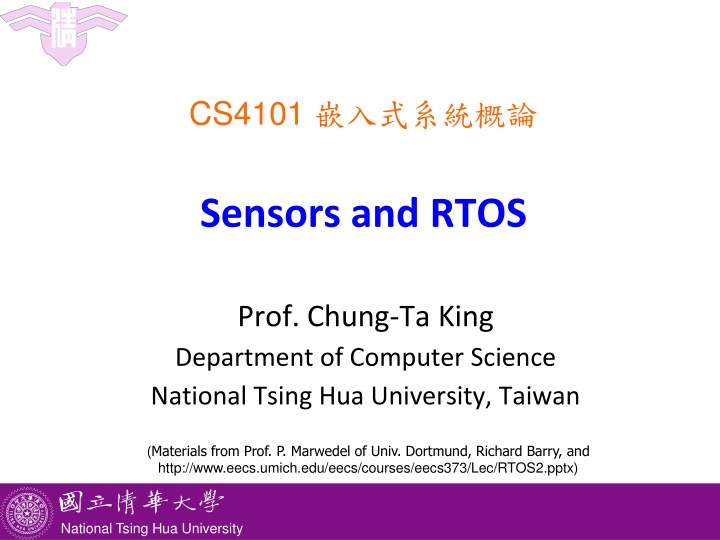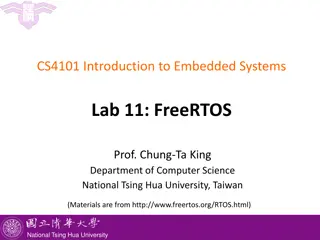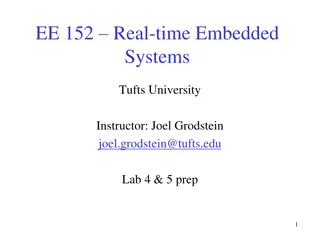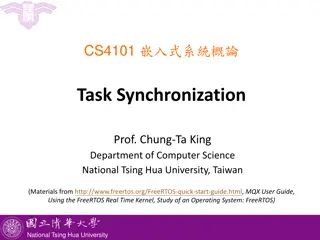
Sensors, RTOS, and Applications Overview
Explore the world of sensors and real-time operating systems (RTOS) through this informative content from National Tsing Hua University. Learn about different types of sensors, their applications, and how they are integrated with RTOS for various functionalities. Discover the role of photoresistors, ultrasonic sensors, microphones, and more in capturing physical data, along with the basics of sensor technology and real-time systems. Dive into the world of sensor applications for acceleration, gesture detection, temperature sensing, and much more, highlighting the diverse uses of sensors in modern technology.
Uploaded on | 0 Views
Download Presentation

Please find below an Image/Link to download the presentation.
The content on the website is provided AS IS for your information and personal use only. It may not be sold, licensed, or shared on other websites without obtaining consent from the author. If you encounter any issues during the download, it is possible that the publisher has removed the file from their server.
You are allowed to download the files provided on this website for personal or commercial use, subject to the condition that they are used lawfully. All files are the property of their respective owners.
The content on the website is provided AS IS for your information and personal use only. It may not be sold, licensed, or shared on other websites without obtaining consent from the author.
E N D
Presentation Transcript
CS4101 Sensors and RTOS Prof. Chung-Ta King Department of Computer Science National Tsing Hua University, Taiwan (Materials from Prof. P. Marwedel of Univ. Dortmund, Richard Barry, and http://www.eecs.umich.edu/eecs/courses/eecs373/Lec/RTOS2.pptx) National Tsing Hua University
Outline Sensors Photoresistors, ultrasonic sensors, microphone Embedded and real-time operating systems Embedded operating systems Overview of real-time systems Real-time operating systems (RTOS) FreeRTOS Tasks Link to FreeRTOS on Arduino 1 National Tsing Hua University
What Is a Sensor? A sensor is a device that detects either an absolute value or a change in a physical or electrical quantity, and converts that change into a useful input signal (often analog signals) for a decision making center. Actuator or Output Data Processing, Control, Connectivity Sensor Input 2 National Tsing Hua University
Sensors For capturing physical data Sensors can be designed for virtually every physical and chemical stimulus. Heat, light, sound, weight, velocity, acceleration, electrical current, voltage, pressure, Chemical compounds Many physical effects can be used for constructing sensors Law of induction (generation of voltages in an electric field), light-electric effects. 3 National Tsing Hua University
Sensor Applications Acceleration Gesture detection Tilt to control Tap detection Position detection Orientation Gyroscopic Magnetic Ambient light sensing Temperature/humidity Motion detection Pressure Medical Barometer/altimeter Engine control/tire pressure HVAC applications Water level Video/Audio/Lidar Surveillance Object detection Depth detection Speech recognition Touch Touch detection Appliance control panels Touch panels Multiple sensors working together for next generation applications sensor fusion 4 National Tsing Hua University
Photoresistor Photoresistor is a light-controlled variable resistor, made of a high resistance semiconductor The resistance of a photoresistor decreases with increasing incident light intensity In the dark, a photoresistor can have a resistance as high as several megohms (M ) While in the light, a photoresistor can have a resistance as low as a few hundred ohms 5 National Tsing Hua University
Photoresistor and Arduino 6 National Tsing Hua University
Sample Code for Photoresistor void setup() { Serial.begin(9600); pinMode(A0, INPUT); pinMode(13, OUTPUT); digitalWrite(13, LOW); } int pr_min = 400; void loop() { int pr = analogRead(A0); /* Read value of A0 input (must in range of 0~1023) */ Serial.println(pr); digitalWrite(13, pr > pr_min ? LOW : HIGH); /* If input value > pr_min, then flash LED */ delay(1000); } Analog input (0~5V) with 10-bit ADC 7 National Tsing Hua University
Ultrasonic Sensor An ultrasonic sensor emits an ultrasound that travels through the air; if there is an object or obstacle on its path It will bounce back to the sensor Considering the travel time and the speed of the sound, the distance can be calculated Ex.: HC-SR04 Effectual angle: <15 Ranging distance : 2cm 500 cm Resolution : 0.3 cm 40KHz ultrasonic signal 4 pins: Vcc, Trig, Echo, GND 8 National Tsing Hua University
Distance Calculation Set the Trig pin on at HIGH for > 10 s to start That will send out an 8-cycle sound wave that can be received in the Echo pin Echo pin will be HIGH based on the time in microseconds that the sound wave traveled Distance = HIGH Duration*(Sonic:340m/s)/2 HC-SR04 Timing Diagram 10 s tripper pulse Trigger Pin 8 x 40kHz sound wave Transmit Wave Width proportional to measured distance Echo Pin 9 National Tsing Hua University
Distance Calculation: Example So in order to get the distance in cm we need to multiply the received travel time value from the Echo pin by 0.034 cm/ s and divide it by 2 10 National Tsing Hua University
Ultrasonic Sensor and Arduino HC-SR04 has 4 pins: Ground, Vcc, Trig, Echo Vcc is connected to the 5 volt pin, trig and echo pins to any digital I/O pin on Arduino Uno 11 National Tsing Hua University
Ultrasonic Sensor and Arduino pulseIn()reads a pulse (either HIGH or LOW) on a pin Syntax : pulseIn(pin, value) If value is HIGH, pulseIn() waits for the pin to go HIGH, starts timing, then waits for the pin to go LOW and stops timing Returns the length of the pulse in microseconds or 0 if no complete pulse was received within the timeout Echo Pin Time it takes pulse to leave and return to sensors 12 National Tsing Hua University
Sample Code for Ultrasonic Sensor const int trigPin = 12, echoPin = 11; long duration, distance; void setup() { pinMode(trigPin, OUTPUT); pinMode(echoPin, INPUT); } void loop() { digitalWrite(trigPin, LOW); // Clears the trigPin delayMicroseconds(2); /* Sets the trigPin on HIGH state for 10ms */ digitalWrite(trigPin, HIGH); delayMicroseconds(10); digitalWrite(trigPin, LOW); /* Reads Echo pin, returns sound travel time in ms */ duration = pulseIn(echoPin, HIGH); /* Calculating the distance */ distance = duration*0.034/2; } 13 National Tsing Hua University
KY-038 Microphone Sound Sensor Detect when sound has exceeded a set point Sound is detected via a microphone and fed into an LM393 op amp The sound level set point is adjusted via an on-board potentiometer When the sound level exceeds the set point, an LED on the module is illuminated and the output is sent low 14 National Tsing Hua University
KY-038 Microphone Sound Sensor Module has four outputs: (inputs to Arduino) AO, analog output: real-time output voltage signal of the microphone DO, digital output: when the sound intensity reaches a certain threshold, output high and low signal Vcc GND 15 National Tsing Hua University
Sample Code for Digital Input int Led = 13 int sensorpin = 12; int val = 0; void setup() { pinMode(Led, OUTPUT); pinMode(sensorpin, INPUT); } void loop() { val = digitalRead(sensorpin); /* digital interface will be assigned a value of pin 12 to read val */ if (val == HIGH) { digitalWrite(Led, HIGH); } else { digitalWrite(Led, LOW); } } 16 National Tsing Hua University
Sample Code for Analog Input int sensorPin = A0; int ledPin = 13; int sensorValue = 0; void setup() { Serial.begin(9600); pinMode(ledPin, OUTPUT); } void loop() { sensorValue = analogRead(sensorPin); digitalWrite(ledPin, HIGH); delay(sensorValue); digitalWrite(ledPin, LOW); delay(sensorValue); Serial.println(sensorValue, DEC); } 17 National Tsing Hua University
Outline Sensors Photoresistors, ultrasonic sensors, microphone Embedded and real-time operating systems Embedded operating systems Overview of real-time systems Real-time operating systems (RTOS) FreeRTOS Tasks Link to FreeRTOS on Arduino 18 National Tsing Hua University
Operating Systems The collection of software that manages a system s hardware resources Often include a file system module, a GUI and other components Often times, a kernel is understood to be a subset of such a collection Characteristics Resource management Interface between application and hardware Library of functions for the application User Application Operating System HARDWARE 19 National Tsing Hua University
Embedded Operating Systems Fusion of the application and the OS to one unit Characteristics: Resource management Primary internal resources Less overhead Code of the OS and the application mostly reside in ROM User Operating System + Application HARDWARE 20 National Tsing Hua University
Desktop vs Embedded OS Desktop OS: applications are compiled separately from the OS Embedded OS: application is compiled and linked together with the embedded OS On system start, application usually gets executed first, and it then starts the RTOS Typically only part of RTOS (services, routines, or functions) needed to support the embedded application system are configured and linked in (Dr Jimmy To, EIE, POLYU) 21 National Tsing Hua University
Characteristics of Embedded OS Embedded OS need to be configurable: No single OS fit all needs install only those needed e.g., conditional compilation using #if and #ifdef Device drivers often not integrated into kernel Embedded systems often application-specific specific devices move devices out of OS to tasks Embedded OS Standard OS kernel 22 National Tsing Hua University
Characteristics of Embedded OS Protection is often optional Embedded systems are typically designed for a single purpose, untested programs rarely loaded, and thus software is considered reliable Privileged I/O instructions not necessary and tasks can do their own I/O, e.g., switch is address of some switch Simply use load register, switch instead of OS call Real-time capability Many embedded systems are real-time (RT) systems and, hence, the OS used in these systems must be real-time operating systems (RTOSs) 23 National Tsing Hua University
What is a Real-Time System? Real-time systems have been defined as: "those systems in which the correctness of the system depends not only on the logical result of the computation, but also on the time at which the results are produced" J. Stankovic, "Misconceptions about Real-Time Computing," IEEE Computer, 21(10), October 1988. 24 National Tsing Hua University
Real-Time Characteristics Pretty much typical embedded systems Sensors and actuators all controlled by a processor The big difference is timing constraints (deadlines) Tasks can be broken into two categories1 Periodic Tasks: time-driven, recurring at regular intervals An air monitoring system taking a sample every 10 seconds Flash LEDs in 1 Hz Aperiodic: event-driven The airbag of a car having to react to an impact Press a button 1Sporadic tasks are sometimes considered as a third category. They are tasks similar to aperiodic tasks but activated with some known bounded rate, which is characterized by a minimum interval of time between two successive activations. 25 National Tsing Hua University
Soft, Firm and Hard deadlines The instant at which a result is needed is called a deadline If the result has utility even after the deadline has passed, the deadline is classified as soft, otherwise it is firm If a catastrophe could result if a firm deadline is missed, the deadline is hard 26 National Tsing Hua University
Goals of an RTOS Manage to meet RT deadlines Also like Deadlines met Ability to specify scheduling algorithm Interrupts are fast Interrupt prioritization easy to set Tasks stay out of each others way Normally through page protection Device drivers already written (and tested!) for us Portable runs on a huge variety of systems Nearly no overhead so we can use a small device! That is a small memory and CPU footprint 27 National Tsing Hua University
Requirements for RTOS Predictability of timing behavior of the OS Upper bound on execution time for all OS services Scheduling policy must be deterministic Period in which interrupts are disabled must be short (to avoid unpredictable delays in processing critical events) OS should manage timing and scheduling OS has to be aware of task deadlines (unless scheduling is done off-line) OS should provide precise time services with high resolution Important if internal processing of the embedded system is linked to an absolute time in the physical environment 28 National Tsing Hua University
Functionality of RTOS Kernel Processor management Memory management Timer management Task management (resume, wait, etc.) Inter-task communication Task synchronization resource management 29 National Tsing Hua University
Outline Sensors Photoresistors, ultrasonic sensors, microphone Embedded and real-time operating systems Embedded operating systems Overview of real-time systems Real-time operating systems (RTOS) FreeRTOS Tasks Link to FreeRTOS on Arduino 30 National Tsing Hua University
FreeRTOS FreeRTOS is nothing but software that provides multitasking facilities Allows to run multiple tasks and has a simple scheduler to switch between tasks (priority-based multitasking) Fully preemptive Always runs the highest priority task that is ready to run Context switch occurs if a task/co-routine blocks or a task/co-routine yields the CPU Queues to communicate between multiple tasks Semaphores to manage resource sharing between multiple tasks Utilities to view CPU utilization, stack utilization etc. (http://www.socialledge.com/sjsu/index.php?title=FreeRTOS_Tutorial) 31 National Tsing Hua University
Tasks In FreeRTOS each thread of execution is called a task Tasks are implemented as C functions that must return void and take a void pointer parameter: void ATaskFunction(void *pvParameters); A task is a small program that has an entry point, will normally run forever within an infinite loop, will not exit void ATaskFunction(void *pvParameters) { /* Each instance of task will have its own copy of variable */ int iVariableExample = 0; /* A task is normally implemented in infinite loop */ for( ;; ) { /* task functionality */ } /* Should the code ever break out of the above loop then the task must be deleted. */ vTaskDelete(NULL); /* NULL: this task */ } 32 National Tsing Hua University
Task Creation xTaskCreate( pvTaskCode, pcName, usStackDepth, pvParameters, uxPriority, pxCreatedTask ) pvTaskCode: pointer to task entry function, implemented to never return pcName: a descriptive name for the task to facilitate debugging usStackDepth: size of task stack, specified as the number of variables that the stack can hold pvParameters: pointer to parameters for the task uxPriority: priority at which the task should run pvCreatedTask: pass back a handle by which the created task can be referenced 33 National Tsing Hua University
Example: Creating a Task void setup() { Serial.begin(9600); while(!Serial){;} // wait for serial port to connect. /* Now set up two tasks to run independently */ xTaskCreate( vTask1, /* Pointer to function for the task */ (const portCHAR *) "Task1", /* Name for the task */ 128, /* Stack Size */ NULL, /* NULL task parameter */ 1, /* This task will run at priority 1 */ NULL ); /* Do not use the task handle */ xTaskCreate( vTask2, "Task2", 1000, NULL, 1, NULL ); /* Now the task scheduler, which takes over control of scheduling individual tasks, is automatically started */ } 34 National Tsing Hua University
Example: Creating a Task void vTask1(void *pvParameters) { (void) pvParameters; for( ;; ){ /* read the input on analog pin 0 */ int sensorValue = analogRead(A0); /* print out the value you read */ Serial.println(sensorValue); /* one tick delay in between reads for stability */ vTaskDelay(1); } } 35 National Tsing Hua University
Link to FreeRTOS on Arduino There is a FreeRTOS implementation in Arduino IDE Go to Sketch -> Include Library -> Manage Libraries to open Arduino IDE Library manager 36 National Tsing Hua University
Link to FreeRTOS on Arduino In the Arduino IDE Library manager (from Arduino Version 1.6.8) look for the FreeRTOS Library Type: Contributed and Topic: Timing 37 National Tsing Hua University
Link to FreeRTOS on Arduino Under the Sketch -> Include Library , ensure that the FreeRTOS library is included in your sketch 38 National Tsing Hua University
Example: Blink_AnalogRead #include <Arduino_FreeRTOS.h> /* define two tasks for Blink & AnalogRead */ void TaskBlink(void *pvParameters); void TaskAnalogRead(void *pvParameters); void setup() { Serial.begin(9600); while (!Serial) { ; // wait for serial port to connect. } /* Now set up two tasks to run independently */ xTaskCreate( TaskBlink, (const portCHAR *)"Blink", 128, NULL, 2, NULL ); xTaskCreate( TaskAnalogRead, (const portCHAR *) "AnalogRead", 128, NULL, 1, NULL ); 39 National Tsing Hua University
Example: Blink_AnalogRead void TaskAnalogRead(void *pvParameters) { (void) pvParameters; for (;;) { /* read the input on analog pin 0 */ int sensorValue = analogRead(A0); /* print out the value you read */ Serial.println(sensorValue); /* one tick delay in between reads for stability */ vTaskDelay(1); } } 40 National Tsing Hua University




